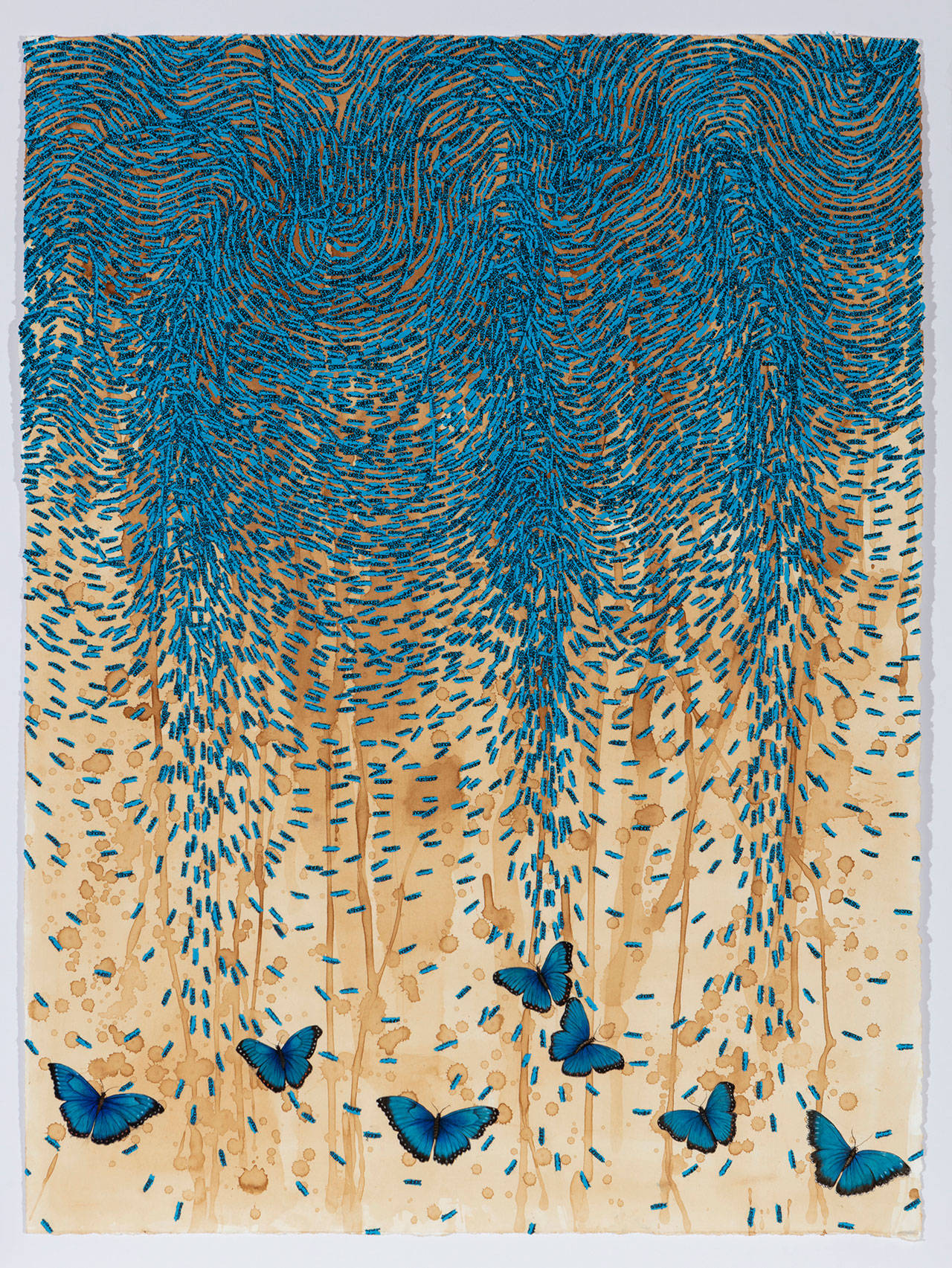By Vanessa H. Larson
The Washington Post
WASHINGTON, D.C. — Ambreen Butt makes a striking first impression.
In the Pakistani-American artist’s first solo exhibition in D.C., two large images hang on the wall just opposite the entrance to her show, “Mark My Words,” at the National Museum of Women in the Arts. Titled “Pages of Deception,” the diptych appears, from a distance, like facing folios of paper in a calligraphic Islamic manuscript, with traditional filigree borders. On closer inspection, however, these 70.5-by-45-inch “pages” are taken up with overlapping circles of shredded and collaged snippets of paper: the transcript of the 2011 terrorism trial of Egyptian-American Tarek Mehanna, who was sentenced to 17 years in prison by a Boston jury. The thousands of indecipherable text fragments – the left side representing the prosecution’s closing argument, with the defense’s statement on the right – seem to swirl almost into meaninglessness, in a powerful commentary on the inscrutability of justice.
All of the exhibition’s 13 works on paper reward such close examination and engagement. The artist builds on her training in classical Indo-Persian miniature painting, incorporating an array of other techniques to explore contemporary political narratives.
The most compelling pieces in the show are part of Butt’s “Say My Name” series, an ongoing project that calls to mind the Black Lives Matter movement in its emphasis on the act of witnessing. Each intricate, labor-intensive work is titled after an actual child who has been killed in an American drone strike in Pakistan or Afghanistan. Working on tea-stained surfaces, Butt combines tiny shreds of paper bearing the children’s names and ages — one is Ayeesha, a girl of just 3 — with colorful painted motifs. These include a half-dozen butterflies in brilliant blue and an East Asian-inspired dragon.
Unlike some conceptual or political art, which all too often conveys its message at the expense of its aesthetics, these works are both emotionally resonant and visually captivating. For Butt, making beautiful art about ugly subjects is a conscious choice.
“We are bombarded with these terminologies like ‘collateral damage,’ ” Butt said. “You have no idea that there was a person’s life, and that life was connected with so many lives. That’s why I use aesthetics in my work. It becomes a vehicle for the viewer to enter into the landscape of the work.”
Several other pieces in the show grapple with gender, drawing on recent Pakistani history. In Butt’s “Dirty Pretty” series — inspired by a 2007-2009 protest by Pakistan’s lawyers in response to President Pervez Musharraf’s intervention in the judiciary — the artist juxtaposes portraits of female lawyers, accented with hand-stitching, with painted hunting scenes evoking traditional Mughal miniatures, in a reflection on power dynamics, past and present.
Concurrent with Butt’s show at the NMWA, the Smithsonian’s National Portrait Gallery is coincidentally also showcasing several etchings by a kindred spirit: Shahzia Sikander, a 2006 MacArthur Fellow who had a well-regarded solo exhibition at the Hirshhorn Museum and Sculpture Garden in 1999 and 2000 devoted to paintings inspired by Indo-Persian miniatures. (Sikander is the first artist from Pakistan to have her work acquired by the museum and displayed.) Her works on view include two luminous self-portraits – you’ll find them in “Eye to I: Self-Portraits From 1900 to Today” — and two portraits of Ayad Akhtar, the Pakistani-American writer who won the 2013 Pulitzer Prize for drama. Akhtar’s portraits are on view among the recent acquisitions.
Although Sikander’s training isn’t immediately evident in the style and technique of these pictures, it comes through in their composition and iconography, which reference traditional Islamic depictions of the Mi’raj, or ascension of Muhammad into heaven. In one mesmerizing portrait of Akhtar, the subject’s head is shown in profile on a starry, night-blue background, both surrounded by and overlaid with fantastical images of flames, angels and mythical creatures, evoking the prophet’s dreamlike journey.
The practice of miniature painting demands a meticulous attention to detail, and a repetitive — almost meditative — application of tiny amounts of paint. As Butt puts it, you make marks “over and over again, and eventually your marks become visible.” But this centuries-old art form is far from static.
Butt and Sikander have reinvented time-honored techniques for a contemporary audience while retaining their works’ intimate connection with the viewer. As these remarkable artists prove, making one’s mark sometimes means rewriting the rules.
Talk to us
> Give us your news tips.
> Send us a letter to the editor.
> More Herald contact information.

























